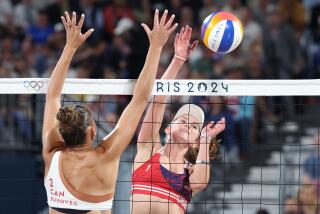Beach Volleyball’s Guru: The Sandman
LONDON — When Sinjin Smith was growing up playing beach volleyball in Southern California two decades ago, nobody really cared about the grainy stuff they played on.
Tournament organizers simply raked the sand, draped ragged nets from crooked poles and threw in some tanned bodies and a ball to complete the mix.
“It was great, but we simply didn’t know any better,” said the 42-year-old Smith, a beach volleyball pioneer and five-time world champion.
This cavalier approach worked before the sport gained Olympic status in Atlanta in 1996 and advertisers got interested. But not now.
Volleyball’s world governing body (FIVB) has hired an “official sand consulting and testing company” to clean up the sediment-- and TV image.
All sand is not created equal, which is spelled out in detail in an FIVB “sand specification sheet” that reads like a geology textbook.
It can be too coarse, too fine and --upon very close inspection--grains can be as round as marbles, producing “deep sand that’s like playing in quicksand,” Smith said.
Hard-packed sand plays like asphalt. The bright, white variety is a television washout, and dirty sand stinks under bright sun or TV lights.
“It would be very vile if it smells,” said Todd Knapton, who heads the “V-sand” division of Canada-based Hutcheson Sand & Mixes--the FIVB’s sand experts.
“Seaweed is a mess, and rotting fish--you can imagine. If there’s soil in the sand, players come up dirty. You don’t want athletes getting up looking like they’ve been dragged through the garden.”
Three beaches are world famous for volleyball--Hermosa in California, Copacabana in Brazil and Bondi in Australia. But the world’s best sand? It may be Canadian.
The Huntsville, Ontario, company trucked in 490 tons from a Canadian glacial deposit--the Muskoka area of southern Ontario--to create a beach for the Goodwill Games in New York’s Central Park in 1998.
Fussy players rated the conditions “the best in history,” prompting Hutcheson to proclaim in its advertising: “The sand that makes the difference.”
Known as “The Sandman” or “True Grit,” Knapton is the sand cop for the Swiss-based FIVB. He tries to level the playing field with sand samples arriving by overnight mail from unlikely beach volleyball sites like Norway, Switzerland, Austria and Macau.
For players, problems with sand are like bad ice on a hockey rink, warped boards on a basketball court, a burned-out putting green or a ski race without snow, said Knapton, who also set up courts for last year’s Pan American Games.
John Child, a 32-year-old Canadian who teamed with Mark Heese to win Olympic bronze in Atlanta, remembers the bad old days on the beach.
“Rocks, glass and syringes were removed,” but not much else, he said.
“In Chile, I remember playing on what was literally volcanic rock-- little black rocks. You couldn’t dive or you’d get road rash and be pulling rock out of your chest,” Child said. “They’d put you on a grass-in-the-backyard kind of place and players got hurt.”
Last year at the FIVB’s world championships in Marseilles, France, several female players were hurt in the sand, which became the talk of the tournament. And last month, a non-FIVB event in Melbourne, Australia, was called off when syringes were found on the court.
Building a solid reputation on sand means being scientific, as Hutcheson’s “spec sheet” points out.
Between 80% and 95% of the mix should consist of sand with particle diameters ranging from 1.0 millimeter (.04 inch) to 0.25 millimeter (.01 inch). Very fine sand, ranging from 0.15 mm (.006 inch) to 0.05 mm (.002 inch), should make up no more than 2%.
The shape is also detailed. FIVB guidelines call for “naturally weathered, sub-angular”--meaning rounded--sand. Crushed rock is prohibited.
“The acceptable sand would be of an aesthetically pleasing, non-glaring color, preferably tan, cream or pale brown,” the guidelines say.
“Seven years ago, before we started to get into this, I would have laughed, too, at knowing so much about volleyball sand,” Knapton said.
More to Read
Go beyond the scoreboard
Get the latest on L.A.'s teams in the daily Sports Report newsletter.
You may occasionally receive promotional content from the Los Angeles Times.






